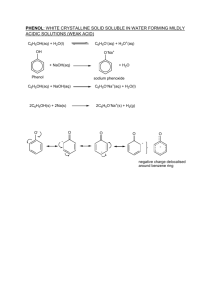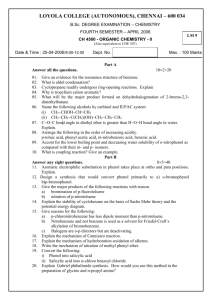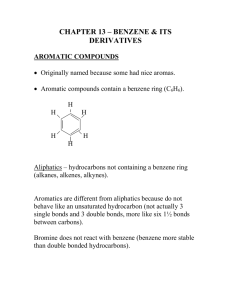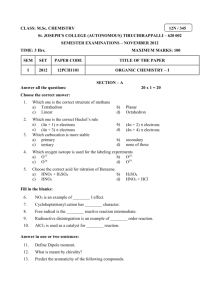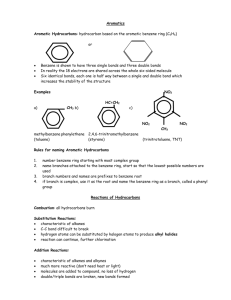Chapter 12 Arenes - benzene and phenol
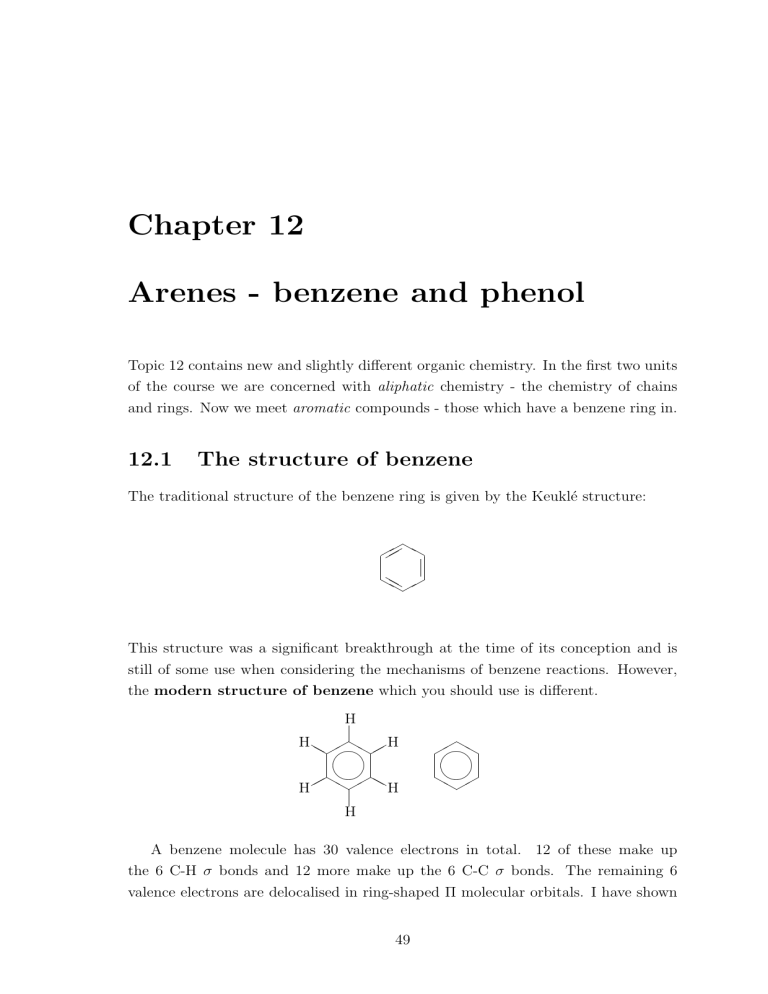
Chapter 12
Arenes - benzene and phenol
Topic 12 contains new and slightly different organic chemistry. In the first two units of the course we are concerned with aliphatic chemistry - the chemistry of chains and rings. Now we meet aromatic compounds - those which have a benzene ring in.
12.1
The structure of benzene
The traditional structure of the benzene ring is given by the Keukl´e structure:
" bb b ""
This structure was a significant breakthrough at the time of its conception and is still of some use when considering the mechanisms of benzene reactions. However, the modern structure of benzene which you should use is different.
H
H
" bb
H
" bb
H
" b b ""
H
H b ""
A benzene molecule has 30 valence electrons in total. 12 of these make up the 6 C-H σ bonds and 12 more make up the 6 C-C σ bonds. The remaining 6 valence electrons are delocalised in ring-shaped Π molecular orbitals. I have shown
49
the hydrogen atoms on one of the above rings because it is important that you remember they are there, although the structure is sometimes abbreviated to the one on the right.
The evidence for the modern structure rather than the Kekul´e structure is as follows:
Hydrogenation of the Kekul´e structure
" bb b ""
+ 3H
2
−−−→
" bb b
"" but the actual result for hydrogenation of benzene is
∆ H
◦
= − 360kJmol − 1
" bb b ""
+ 3H
2
−−−→
" bb b
""
∆ H
◦
= − 208kJmol − 1
This means that benzene has a more stable structure than the Kekul´e structure by 152 kJ mol − 1 . This is due to the delocalisation of electrons in the π ring system.
This enthalpy of delocalisation makes benzene resistant to addition reactions .
X-ray crystallography studies also show us that the C-C bond lengths in benzene do not correspond to either single or double carbon bonds - the bond lengths are the same and are in between the single and double bond values.
12.2
Reactions of arenes
The reactions of benzene derivatives are typified by electrophilic substitution . The delocalised π electrons will be available for attack by an electrophile. The major difficulty in these reactions is not remember what happens, but remembering how to generate an appropriate electrophile.
50
12.2.1
Bromination
Alkenes typically react with bromine to form addition products. For instance
" bb b
""
+ Br
2
−−−→
" bb
Br b
"" Br
However, a benzene ring reacts with bromine to produce hydrogen bromide
(which can be tested for with ammonia to produce white fumes)
OCH
3
" bb
OCH
3
" bb
+ Br
2
−−−→ + HBr b "" b ""
Br
You might find this easier to see if you remember that there are hydrogen atoms on the ring:
OCH
" bb
3
+ Br
2
−−−→ b ""
H
Further substitution reactions may occur
OCH
3
" bb b ""
Br
+ HBr
OCH
3
" bb b ""
Br
OCH
3
+ Br
2
−−−→
Br b "
" bb b ""
Br
+ HBr
Br Br
Generation of the electrophile
In the reaction of bromine with methylbenzene we need a catalyst, in this case iron.
C
6
H
5
CH
3
+ Br
2
Fe
−−−→
C
6
H
4
(CH
3
)Br + HBr
51
The delocalised electrons need to be attracted to something positive. In this case the bromine molecule is polarised in the following manner. First of all the iron reacts with bromine to form iron (III) bromide.
2Fe + 3Br
2
−→ 2FeBr
3
The iron (III) bromide contains a very electropositive Fe. This can induce polarisation in other bromine molecules:
FeBr
3
+ Br
2
−→ Br δ + − Br δ − .
FeBr
3
This δ + bromine atom is therefore the electrophile to which the ring electrons are attracted. (The catalyst in the reaction is really iron (III) bromide, not iron.)
12.2.2
Sulphonation
In the sulphonation of benzene fuming sulphuric acid is used. This is a mixture of sulphur trioxide and concentrated sulphuric acid. The electrophile is SO
3
. Sulphonation is useful in the synthesis of drugs, dyes and detergents. The product of sulphonation of benzene is called benzenesulphonic acid. This ionises in water to produce a negative benzenesulphonate ion and an oxonium ion.
12.2.3
Alkylation
Alkylation is a really useful reaction as it involves the formation of carbon-carbon bonds. We discuss the Friedel-Crafts alklyation of benzene in topic 12. As in the reaction with bromine, it is the formation of the electrophile which is the tricky bit.
Formation of the electrophile
If we are to encourage an alkyl group to attach to a benzene ring we need an electrophile which has a positive charge on a carbon atom. In the Friedel-Crafts reaction this is generated by mixing an alkyl chloride (RCl) with aluminium chloride
(AlCl
3
). This reacts as follows:
RCl + AlCl
3
−→ R + AlCl −
4
Our alkyl group is now positively charged and open to attack by the electrons in the benzene ring (again, it can help to include one of the ring hydrogens in your
52
equation):
" bb
H
+ R + AlCl −
4
−−−→ b ""
" bb
R
+ AlCl
3
+ HCl b ""
You can see that the aluminium chloride is a catalyst. Although it is changed during the reaction, it is regenerated at the end. Only a tiny bit is needed to make the reaction happen.
Some examples
What are the products of the following alkylation reactions? Do not just include the organic products!
" bb b ""
+ CH
3
Cl
AlCl
3
−−−−−−−→
" bb b ""
+ CH
3
CH
2
Cl
AlCl
3
−−−−−−−→
" bb
¹¸ b ""
+ CH
3
CHClCH
2
CH
3
AlCl
3
−−−−−−−→
53
12.2.4
Nitration
Nitration does not add a nitrate group to a compound, it adds a nitro (NO
2
) group.
Generation of the electrophile
The electrophile in the nitration of arenes is NO +
2
. This is formed in rather savage conditions from a nitrating mixture of concentrated nitric and sulphuric acids:
HNO
3
+ H
2
SO
4
−→ NO +
2
+ 2HSO −
4
+ H
3
O +
The electrophile is very attractive to the delocalised ring electrons and the following reaction takes place:
" bb
H
+ NO +
2
−−−→ b ""
" bb
NO
2
+ H + b ""
Again this is a straightforward electrophilic substitution. This reaction is used to great effect when the arene used is methylbenzene:
" bb b ""
NO
2
CH
3
" bb
+ 3NO +
2
−−−→
NO
2
" b b ""
CH
3
NO
2
+ 3H +
The product, 2,4,6-trinitromethylbenzene, is better known as trinitrotoluene or
TNT. Nitro groups on arenes are also used in the manufacture of dyes.
12.2.5
Oxidation
Benzene itself resists oxidation with acidified potassium manganate (VII). Alkanes are also unaffected by oxidising agents. Alkyl groups attached to benzene rings are able to undergo oxidation to a carboxylic acid group with relative ease. For example
54
methylbenzene gives benzoic acid:
" bb b ""
CH
3 KMnO
4
−−−−−−−→
H
2
SO
4
, heat
" bb
COOH b ""
Extra-interesting is the fact that any alkyl chain (regardless of length) will be oxidised to give benzoic acid and the rest of the carbon chain is oxidised to carbon dioxide and water.
12.3
Phenols
Phenols are compounds with a phenyl group (C
6
H
5
) attached to a hydroxyl group
(OH). The simplest is phenol itself, C
6
H
5
OH:
OH ·
· T
T
T
T
¹¸
Phenols do not behave like typical alcohols. They are soluble in water, but not as soluble as ethanol. The hydroxyl group can form hydrogen bonds with water, but the large hydrocarbon ring decreases the solubility.
It can be instructive to break the reactions of phenols into different classes reactions of the OH, reactions of the lone pair of electrons on the oxygen, reactions of the C-O and reactions of the arene ring.
Test for phenol
Phenol will give a purple colouration with a neutral solution of iron (III) chloride.
Which is nice.
12.3.1
Reactions of the hydroxyl group
Phenol is acidic, but it is very weak. The lone pairs on the oxygen atom may be delocalised around the ring with the other π electrons and in this way a negative charge on the oxygen could also be delocalised. This delocalisation of the charge can
55
stabilise a phenoxide ion. The delocalisation of this charge is rubbish however, as phenols are nowhere near as acidic as carboxylic acids, which still tend to be pretty weak when compared to inorganic acids such as H
3
PO
4
.
" bb
OH b ""
" bb b ""
O −
+ H +
(aq)
(aq) (aq)
You may be asked to explain why phenol is acidic and an aliphatic alcohol, such as propan-1-ol, isn’t. You should write something about the charge being delocalised in the phenoxide ion, but that no such stabilisation by delocalisation is possible in the propoxide ion.
Reaction with sodium
Phenols react just like alcohols do with sodium. Effervescence is observed and a white salt may be observed. This is a sodium phenoxide:
" bb
OH
+ Na −−−→ b ""
" bb
O − Na +
¹¸ b ""
+
1
2
H
2
Reaction with sodium hydroxide
Phenols will react with strong bases such as sodium hydroxide to form sodium phenoxide and water (it’s too similar to the last reaction to write it out again).
Phenols are such weak acids that reaction with sodium carbonate doesn’t happen.
This is probably due to unfavourable energetics, which you don’t need to know about.
12.3.2
Reaction of the lone pair
A substance with a lone pair of electrons is a nucleophile - you’ve probably written this before. Carboxylic acids contain a carbon with a δ + charge which is ripe for nucleophilic attack. (The partial positive charge comes from the carbon being attached
56
to two very electronegative oxygen atoms.) The reaction produces a substance called an ester and eliminates a small molecule (water).
We have already said that the lone pairs of electrons on the oxygen in phenols can interact with the delocalised system of ring electrons. This means that the lone pair on C
6
H
5
OH is less available as a nucleophile than the lone pair in, for instance, ethanol. As a result the reaction of phenols with carboxylic acids gives a poor yield of esters and instead the acid anhydride is used instead of the carboxylic acid. This will be seen in more detail in section 12.4.
12.3.3
Reaction of the carbon-oxygen bond
Unlike aliphatic alcohols, phenol will not undergo nucleophilic substitution reactions
(like S
N
1 and S
N
2). As before, this is due to the interaction of the lone pair of electrons on the oxygen with the delocalised ring electrons. The C-O bond has character between a single and a double bond, so is stronger and shorter than in an aliphatic alcohol.
Propan-1-ol will react with concentrated phosphoric acid to produce propene and water when heated. Phenol does not undergo an elimination reaction like this, as this would introduce another π bond into the ring.
The hydroxyl group is not easily oxidised to a carbonyl group because the stable benzene ring would be disrupted. This means that although a primary alcohol can be oxidised to an aldehyde
CH
3
CH
2
K
2
Cr
2
OH −−−−−−−→
H +
O
7
CH
3
CHO and a secondary alcohol to a ketone
CH
3
CH
O
HCH
3
K
2
Cr
2
O
7
−−−−−−−→
H +
CH
3
COCH
3 phenol just sits there
" bb
OH
¹¸ b ""
K
2
Cr
2
O
7
−−−−−−−→
H +
No reaction
57
12.3.4
Phenol as an arene
Remember that the reactions of arene rings are typically electrophilic substitutions.
The lone pairs of electrons on the oxygen in phenol interact with the delocalised ring electrons, making it even more likely that a substitution reaction will occur.
We often see multiple substitution.
OH
" bb b ""
OH
+ 3Cl
2
−−−→
Cl b "
" bb b ""
Cl
Cl
+ 3HCl
The product, 2,4,6-trichlorophenol is TCP, an antiseptic. Phenols are often good antiseptics, and phenol was the first antiseptic used in surgery (even though it makes incisions take longer to heal). Dettol is just a glorified version of phenol and TCP.
Dettol is also easier to say than 4-chloro-3,5-dimethylphenol:
OH
" bb
CH
3
" b ""
Cl
CH
3
Picric acid is the common name for 2,4,6-trinitrophenol. It can be formed by reaction of phenol with concentrated nitric acid. Try to draw the displayed formula for picric acid below:
58
12.4
Preparation of aspirin
The chemistry behind the preparation of aspirin is fairly straightforward. We form an ester between the hydroxyl group of 2-hydroxybenzoic acid and ethanoic anhydride.
COOH
" bb
OH
+ (CH
3
CO)
2
H
3
PO
4
O
−−−−−−−→ b ""
COOH
" bb
O
2
C-CH
3
+ CH
3
COOH b
""
The important part of the experiment is really the recrystallisation.
We are trying to separate our product from two types of impurity: soluble and insoluble. The recrystallisation method relies on the fact that our desired product is much more soluble in hot solvent than in cold solvent (in this case the solvent is water, although it doesn’t have to be). Our impure solid is collected by suction filtration. The residue, which is what we want, is then mixed with the smallest possible quantity of hot water needed to dissolve the product. This mixture should then be filtered through hot filtration apparatus. This removes the insoluble impurities as a residue and gives us a filtrate containing our product and soluble impurities.
Cooling on ice recrystallises the product and we hope that the soluble impurities remain in solution, thereby enabling us to filter off our desired product and dry it.
The purity of the product can be assessed by measuring its melting point. If the temperatures at which it starts to melt and is completely liquid are close together we can be pretty sure that we have a pure product.
12.5
Preparation of oil of wintergreen
Oil of wintergreen and aspirin have similar uses - pain killing and anti-inflammatory, although one is normally ingested and the other applied as an ointment. To prepare oil of wintergreen we make another ester with 2-hydroxybenzoic acid, but instead of reacting with the hydroxyl group we react with the acidic part.
59
COOH
" bb
OH
+ CH
3
H
2
SO
4
OH −−−−−−−→ b ""
CO
2
CH
3
" bb
OH
+ H
2
O b
""
In the preparation of aspirin we used an acid anhydride (ethanoic anhydride) instead of an acid - the mixture only needed refluxing for about 5 minutes. In this synthesis we are using an organic acid and an alcohol, so the reaction takes longer to give a reasonable yield and refluxing is carried out for about an hour.
As the name implies, oil of wintergreen is a liquid. In this synthesis we try to purify our liquid product instead of our solid product. The method for this is given in some detail on p 291 of the text book.
• Separate the organic (upper) and aqueous (lower) layers. Use an organic solvent to dissolve your product in.
• Wash the organic layer with sodium carbonate solution - where does the pressure build-up come from?
• Separate the organic and aqueous layers again.
• Dry the organic layer with anhydrous sodium sulphate (spoon a load of solid into a conical flask and mix it well).
• Filter off the anhydrous sodium sulphate (you can simply pour the contents of a conical flask through cotton wool to do this).
• Distil off the solvent.
• Continue heating to distil off your product, noting the boiing point of the fractions as they come through the apparatus.
12.6
Summary
The reactions of benzene and phenol are not dominated by their alkane/alkene nature or their alcoholic nature. Rather it is the delocalisation of electrons in the π system of the aromatic ring which influences their reactivity. Phenols have lone pairs of electrons which delocalise into this ring system which stops them behaving like typical alcohols. You should try to write spider diagrams showing the reactions of benzenes and phenols and the conditions necessary for these reactions.
60
